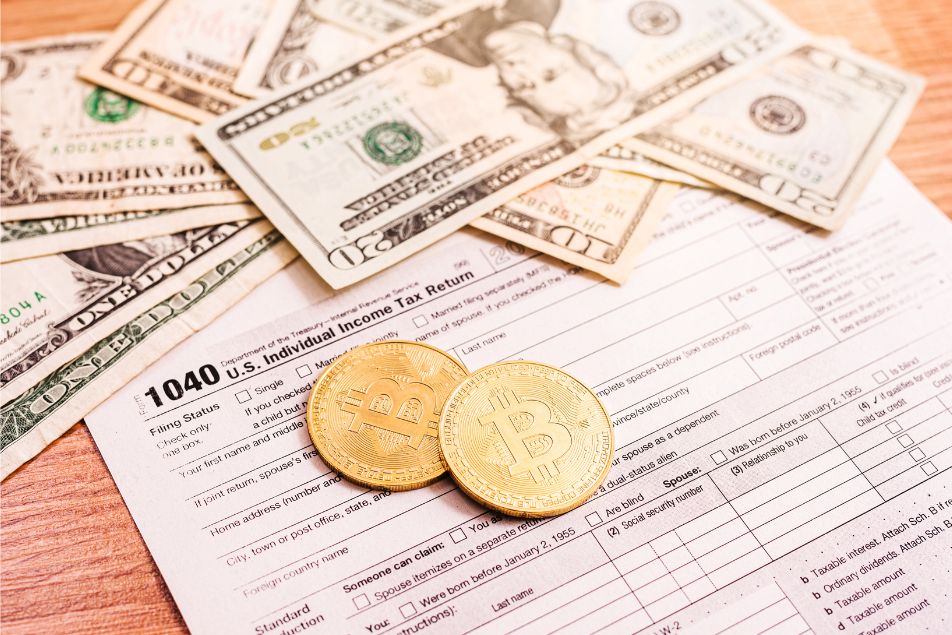How to Report Crypto on Your US Taxes: A Step-by-Step Guide
Wondering whether you need to report crypto on your taxes and how to report your cryptocurrency taxes in the US? This step-by-step guide will take you through how to report gains, losses, and income from crypto.

How to Report Crypto on My Taxes – Step-by-Step
Reporting crypto does not have to be painful; follow this step-by-step guide to demystify the process.
Step 1: Calculate Crypto Capital Gains and Losses
Each time you discard your cryptocurrency, you’ll incur capital gains or losses. Ways of discarding cryptocurrency include:
- Trading cryptocurrency for fiat currency
- Trading one cryptocurrency for a different digital token
- Using cryptocurrency as a means of payment for goods or services
To calculate your loss or gain from each transaction, you’ll need to check how the price of your cryptocurrency has shifted since you first purchased it.
The following formula can be used to calculate how much you’ve lost or gained:
Proceeds from Disposal – Initial Cost = Capital Gain or Capital Loss
The proceeds from disposal are the amount you receive for discarding your cryptocurrency. This is usually the fair market value of the crypto at the time of discard, less any transaction fees incurred.
The initial cost is how much it costs you to acquire your cryptocurrency. This is also usually the fair market value of the crypto at the time you receive it in your digital wallet, including any fees paid at the time of the purchase.
Step 2: Complete IRS Form 8949
The IRS Form 8949 is the tax form that specifically reports capital gains and losses. This form must be used to report each crypto sale throughout the tax year. Other non-crypto investments during the tax years must be filed on separate 8949 forms when filing your taxes.
Here’s how to report crypto on your IRS Form 8949:
- Complete the information at the top of the Form 8949
- Tick boxes (a), (b), or (c) for short-term trades section in Part I:
(a) Short-term transactions reported on Form(s) 1099-B, showing basis was reported to IRS
(b) Short-term transactions reported on Form(s) 1099-B, showing basis was not reported to IRS
(c) Short-term transactions not reported on form (s) 1099-B
As of 2023, exchanges must provide taxpayers and the IRS with Form 1099-B. If you have received a 1099-B from a business, you will check (a) or (b). If you have yet to receive Form 1099-B, you must select box (c), although you should contact your exchange regarding the missing 1099-B form.
Organize the information on your Form 8949 with a row for each cryptocurrency transaction:
- Description of property: Describe the discarded asset, whether sold, exchanged, or spent.
- Date acquired (MM/DD/YYYY): Enter the day you purchase the cryptocurrency used for the cost basis of the transaction
- Date sold or disposed of (MM/DD/YYYY): Enter the day you discarded the cryptocurrency
- Proceeds: This is the gross USD value of the disposed crypto
- Cost basis: This is the gross USD value of the crypto when you acquired it. This includes purchases in another cryptocurrency of fiat currency.
- Adjustment to gain or loss: This describes any adjustment to the amount you entered in column (g). Taxpayers usually do not have any adjustments on crypto. However, IRS instructions list capital gain adjustment for use if necessary. For instance, you must report your purchase prices here if you received a Form 1099 without a cost basis.
- Adjustment to gain or loss: This describes any adjustment for the code you entered in column (f). Taxpayers usually do not have any adjustments on crypto.
- Gain (or loss): Subtract column (e) from column (d) and add any figure from column (g) to calculate your net capital gain (or loss) in USD for this transaction.
Follow this guide to list each cryptocurrency transaction.
Include totals for each column at the bottom of the form.
- Total Proceeds: the total of your sales prices for all transactions
- Total Cost or other basis: the total of your acquisition prices for all transactions
- Total Adjustment, if any, to gain or loss: the total of any adjustments
- Total Gain (or loss): the total of your capital gains or losses for all transactions
Repeat these steps to populate the information for any long-term trades in Part II of Form 8949.
Step 3: Include Totals from Form 8949 on Schedule D
Include the total net capital gain or loss in Schedule D.
Schedule D is attached to Form 1040 and is used to report gains and losses from all sources. In addition to short- and long-term gains from crypto investments, other line items to be reported on Schedule D include Schedule K-1s via estates, businesses, and trusts.
Suppose you carry capital losses on crypto forward from previous years or intend to carry capital losses from the current tax year to future years. In that case, this must be reported on Schedule D, too.
Step 4: Reporting Your Crypto Income
You will owe taxes on that crypto if you have received or discarded cryptocurrency in a tax year. In addition, if you have earned income or rewards in cryptocurrency, you will owe income tax on this crypto as you would for ordinary income received in fiat currency.
Filing taxes for crypto income is similar to filing income tax for fiat currency using the same forms.
Crypto profit is often reported as capital gains. In some instances, it is recognized as ordinary income. These include crypto mining, staking, airdrops, hard forks, and lending interest.
Form 1040 Schedule 1 asks, “At any time during 2023, did you (a) receive (as a reward, award, or payment for property or services); or (b) sell, exchange, gift, or otherwise dispose of a digital asset (or a financial interest in a digital asset)?”
This clarifies that the IRS is interested in all crypto transactions, not just sales and swaps.
The total crypto income you have received is included on Form 1040 Schedule 1 on line 8, “Other income.” This does not include income earned through self-employment.
Suppose you are self-employed or an independent contractor, conducting business as a sole trader, partnership member, or directly contracting with a business. In that case, you must report self-employment income on Form 1040 Schedule C and pay crypto self-employment tax.
Self-employed taxpayers can deduct some expenses from their income. For example, deducting crypto mining expenses for equipment and separately metered electricity bills for a crypto mining business may be possible. Refer to Form 8829 Expenses for Business Use of Your Home.
Step 5: Complete Your Return
This concludes your crypto tax reporting. You should now be able to complete the rest of your tax forms and be ready to submit your tax return to the IRS.
How Do I Report My Cryptocurrency Earnings and Rewards on My Taxes?
All earnings and rewards on cryptocurrency are taxable. If you receive crypto via mining or staking, it is considered ordinary income by the IRS. It can be taxed like any income from fiat sources, such as employment or investment dividends.
All ordinary crypto taxable income should be declared on Form 1040 Schedule 1 unless your earnings are from self-employment. For instance, if you use your equipment as a separate energy source to mine crypto, this income would be considered a form of self-employment.
However, any income received using others’ mining equipment or through token staking mechanisms would be considered ordinary income, like earning fiat income through employment from a third party.

What Forms Should I Receive from My Crypto Platform?
Understanding which tax forms you will require to complete your crypto tax returns is important. Your crypto platform should provide you with the following for each crypto transaction:
- Form 1099-B, Proceeds from Broker and Barter Exchanges
- Form 1099-K, Merchant Card and Third-Party Network Payments
- Form 1099-MISC, Miscellaneous Income
How to Use Crypto Tax Forms to Report Your Crypto Transactions
This comprehensive guide helps you understand how to use crypto tax forms to report crypto transactions.
Which IRS Crypto Tax Forms?
To complete your tax return, you will need:
- Form 8949
- Form Schedule D
- Form 1040 Schedule 1 (Form 1040 Schedule 3 for self-employed individuals)
What is the IRS Minimum for Reporting Crypto?
Crypto exchanges send Form 1099-MISC to traders who earn more than $600 through crypto rewards or staking and to the IRS.
However, you must report all taxable income from cryptocurrency on your tax return regardless of the total amount. Not reporting any income will be considered tax fraud.
Conclusion
Reporting tax on your cryptocurrency investments can be an intimidating process. It can be easily simplified by understanding each constituent part of the process, knowing where to find the required information, and knowing how to input it in the right places will help you correctly and accurately complete your return.
Follow this comprehensive guide from Coin Hint experts to help you file your crypto tax returns.
FAQ
-
How much tax do I pay on cryptocurrency?
The amount of tax you pay on cryptocurrency depends on multiple factors. These include your marital status, holding period, and tax bracket.
You will pay income tax when you receive income from cryptocurrencies or discard crypto within 12 months of purchasing, with a rate varying between 10% and 37%. Long-term capital gains tax will be due when you discard cryptocurrency after holding it for at least 12 months at the rate of between 0 and 20%.
-
Should I pay tax on lost or stolen crypto?
The IRS needs comprehensive guidance on whether you must pay tax on lost or stolen crypto. You may qualify for an exemption if you declare crypto loss or theft an investment loss. Speaking with a crypto tax expert is best before deciding your strategy.
-
Do I report crypto if I didn’t sell?
You do not need to report crypto if you don’t sell. Cryptocurrencies and digital assets are treated as property. Tax is only payable when you realize capital gains or losses through discarding your crypto by swapping, selling, or other disposal methods.
-
Do I have to report every crypto transaction?
Yes, all crypto transactions and amounts of earned crypto must be reported on your taxes, even if the earnings are minuscule.
-
What happens if I forget to report crypto on my tax return?
If it was an honest mistake, you can file an amendment to your tax return at any time. However, you will be liable to strict penalties if you do not report cryptocurrency on your taxes with fraudulent intent.
-
What is the penalty for not reporting cryptocurrency?
Intentionally not reporting crypto on your tax return is considered tax evasion. The maximum penalty is a $100,000 fine and up to five years imprisonment.







